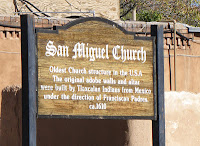Click on Photos to Enlarge!!
When we left The Ranch Escapees Park we weren’t sure where we were going to end up – Las Cruces or Truth or Consequences. We wanted to visit Deb & Jerry in T or C if they were home, but would go on to Las Cruces if they weren’t.
On our way we stopped at Oliver Lee State Park outside Alamogordo to get our Sunset fix
.JPG)
.JPG)
And to revisit the White Sands National Park




We made it to T or C and spent some delightful time with Deb & Jer!
The Chile Tour
While the fellas’ tried to find out if the squealing brakes on the Motor Home were a problem, Deb and I went on a Chile Discovery Tour.
The first thing I learned was that Chile is spelled with an ‘e’ not an ‘i’ – huh – imagine that!
Hatch, New Mexico, the Chile Capital of the World is close to T or C – so off we went.
.jpg) You can see the fields from the road and small growers dry their chiles on sheets on the ground, on metal roofs or car roofs but we wanted to get up close and personal and see what they do with them after they leave the field.
You can see the fields from the road and small growers dry their chiles on sheets on the ground, on metal roofs or car roofs but we wanted to get up close and personal and see what they do with them after they leave the field.The gal at the local service station directed us to a couple of Chile processing plants just up the road.
 At the first plant we were greeted at the door by a fellow covered with chile dust who suggested we go around to the office and someone would show us around. AA Chile Company is a fairly sophisticated operation. We noticed that most workers wore gloves; breathing masks; and nets over their hair and beards.
At the first plant we were greeted at the door by a fellow covered with chile dust who suggested we go around to the office and someone would show us around. AA Chile Company is a fairly sophisticated operation. We noticed that most workers wore gloves; breathing masks; and nets over their hair and beards.Once the chiles are trucked to the plant from the fields, they are washed with a special solution to sterilize them; put onto trays that are on tracks to travel through the drying tunnels that reach 150 degree F.
.JPG)
.JPG)
.JPG)
.JPG)
.JPG) Most of AA’s chiles crushed and sold wholesale to food companies. Paprika is one product they produce from those specialized chiles.
Most of AA’s chiles crushed and sold wholesale to food companies. Paprika is one product they produce from those specialized chiles.The second plant (MBJ Packing) is family run and our tour was with two of the brothers (Angel and Manuel). They not only dry chiles, they produce salsa and do custom packing. Their mother was working in the area where they make the salsa and do the customized packing. Angel does the marketing in El Paso but he was at the plant because they were busy and needed his help.
Their process is different because they pack some of the chiles whole – dried but supple so the chiles can be packed into boxes without damaging them.






We discovered that the long string of chiles that are sold all over are called Ristras. The Ristras are mostly decoration now but originally they were a way to dry the chiles to use later.


 So Deb and I decided to try our hand at stringing the chiles. After we finished, we found directions on how to do it. Yes, they did fall apart but that was okay – we just put them into the freezer until we get the courage up to try to cook with them.
So Deb and I decided to try our hand at stringing the chiles. After we finished, we found directions on how to do it. Yes, they did fall apart but that was okay – we just put them into the freezer until we get the courage up to try to cook with them.



















